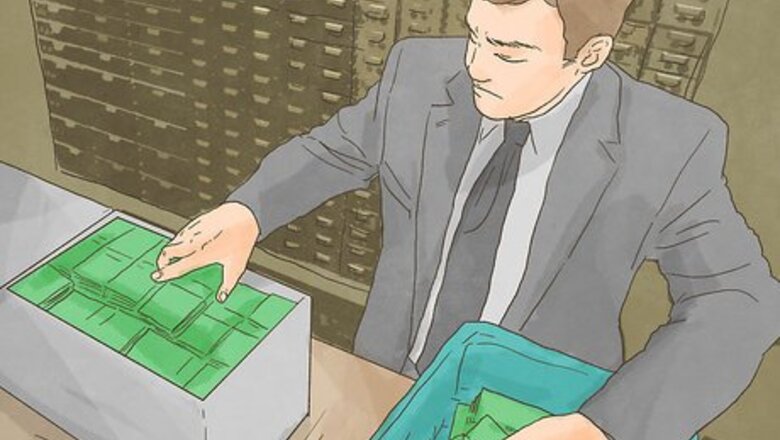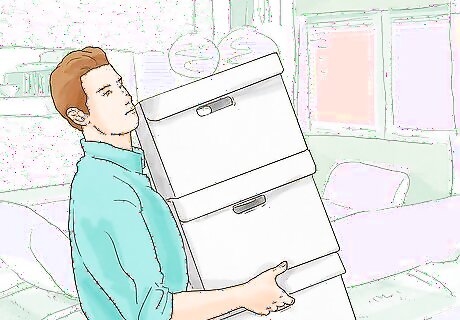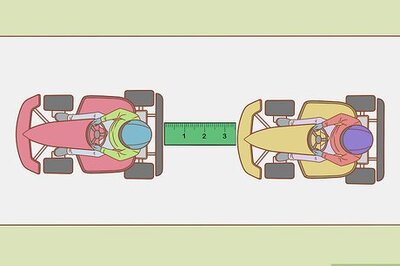
views
Distributing Assets Outside of Probate

Transfer bank account funds. One piece of property that can be distributed outside of probate is bank accounts. If you are the administrator of an estate or trustee of a trust, you will need to know if bank accounts need to be included in your property inventory or if it was passed along in some other manner. The manner in which a bank account is passed outside of probate will depend on how the account is titled and the type of paperwork the decedent filled out with the bank. For example: If the bank account is held jointly between the decedent and one or more other people, the survivors named on the account will receive the funds. As an administrator, you can transfer the funds by simply providing the bank with a copy of the death certificate. The decedent can name a payable on death (POD) beneficiary who will receive the funds upon the decedent's death. The decedent does this by signing a beneficiary form with the bank. To transfer the funds, you will need to provide the bank with a copy of the death certificate.

Find investment accounts. Some investment accounts (e.g., mutual funds and brokerage accounts) can be designated as transfer on death (TOD) accounts, which means the funds in these accounts will be transferred to the named beneficiaries when the account holder passes away. The decedent accomplishes this by signing a beneficiary form with the investment firm where the account is held. To transfer the funds to beneficiaries, you will need to show the investment firm a copy of the death certificate.

Look at the decedent’s real property deeds. Real property (i.e., homes and land) can be passed to beneficiaries in various ways to avoid probate. This is important because real property is often some of the most valuable property the decedent owns. Passing it along outside of probate will help avoid tax liability and debt liability. In most states, real property can be passed outside of probate in the following ways: If title is held by both spouses as tenants by the entirety. This designation will need to be included on the title document itself. If it is, the property will automatically pass to the surviving spouse. You will not need to do anything. If title is held by both spouses as community property in Alaska with a right of survivorship. If it is, the property will automatically pass to the surviving spouse and you will not be required to do anything. If a trustee distributes the property through a trust. If the decedent recorded a TOD deed. A TOD deed, like a TOD investment account, names a beneficiary who will take title to the real property upon the decedent's death. You will not need to do anything to effectuate this distribution either.

Pass insurance type benefits to named beneficiaries. Like POD bank accounts, insurance, annuities, and retirement benefits will usually give the decedent the option of naming a beneficiary. To pass the property to the POD beneficiaries, you will have to provide the account holder with a copy of the death certificate.

Be careful with IRAs, life insurance policies, and 401(k)s. Some property is distributed to beneficiaries with some quirks and special rules. The most common forms of interestingly distributed property include IRAs, life insurance policies, and 401(k)s. Certain laws and bank policies will limit who can be named as a beneficiary and how the money can be distributed. Check each policy carefully so you know exactly how it needs to be distributed. For example, a 401(k) must name the decedent's spouse as their beneficiary unless the spouse signs a waiver. If you need to distribute a 401(k), you need to make sure the spouse is the beneficiary or that you have a signed waiver. Distributions from an IRA will be determined by how old the decedent was and what the beneficiary wants to do with the account. For example, if the beneficiary is the decedent's spouse and the decedent was under the age of 70 1/2, the spouse can choose to transfer the IRA into their own name, take periodic distributions, or take a lump sum distribution. Life insurance policies are interesting because of rules about making distributions to minors. Most insurance providers will not make distributions to minors named as beneficiaries. Instead, you will have to wait until the child reaches an adult age to make distributions or you will have to distribute the funds to a court appointed guardian.

Assume spouses own certain pieces of personal property jointly. A lot of tangible personal property (e.g., furnishings, jewelry, artwork, tools, equipment) does not usually have a title associated with it. If you encounter this property and it does not have a physical title, you can usually assume that it will automatically pass to the surviving spouse. In these circumstances, it is assumed the surviving spouse held the property with the decedent as tenants by the entirety. If this is the case in your state, there is no need to do anything. The property will automatically be transferred upon death. However, if the decedent did not have a spouse, the personal property will usually have to be probated unless it was transferred into a trust.
Allocating Assets Through a Will

Set up an estate bank account. If you are the administrator if the decedent's estate and their property is passed on by a will, the property will be owned by the estate at the point the decedent passes away. Once property is a part of the decedent's estate, it can only be transferred to beneficiaries after all estate debts have been settled. One of your first tasks as an administrator will be to open an estate bank account, which will be used to keep estate assets separate from your personal assets. Any earnings or income from estate property will be placed in the account. Any debts and taxes owed by the estate will be paid out of the estate bank account. Any cash distributions to beneficiaries will be paid out of the estate bank account. To set up an estate bank account, visit your local bank and present them with a copy of the death certificate, letters of administration from the probate court (letters proving you are the administrator), and a TIN. Ask the bank to set up an estate account for you. They will use the documents you provide to set up the account and get things started. You can obtain a TIN by contacting the IRS. The IRS will ask you for your personal information as well as your reason for needing a TIN. Once you complete the application you will receive a TIN.

Know when you can make distributions. As the administrator of the decedent's estate, you cannot make distributions to beneficiaries until allowances and creditor claims have been paid in full. If there is not enough money in the estate to pay all of these expenses, no distributions can be made. However if you are sure the estate has enough funds to pay creditors and allowances, you can choose to transfer property to beneficiaries at any time. If you are not sure, wait until debts have been paid.

Prepare a proposal for distribution. Before you distribute any property, you might choose to send a proposal for distribution to all the beneficiaries. While it is not usually required, a proposal is a good idea if probate has been contested. Probate can be contested in many ways, one of which is by a beneficiary who believes they are not getting what they deserve. Probate courts might have a proposal form you can use. If so, simply fill the form out. However, if you need to create your own, the proposal should include the following information: How you intend to distribute the property The names of everyone who will receive property The property each beneficiary will receive The value of the property each person will receive That each beneficiary can object to the proposal if they send a written objection to you within a certain period of time prescribed by law (usually around 30 days)

Transfer title of each item to the correct beneficiary. Once every beneficiary agrees to the distributions you plan on making, you can start transferring the assets. Each type of property will require different transfer processes. If you are unsure about how to make a particular distribution, you can ask for help from an attorney or other professional. Most assets can be distributed by preparing a new deed, changing the account title, or by giving the person a deed of distribution. For example: To transfer a bank account to a beneficiary, you will need to provide the bank with a death certificate and letters of administration. When you do this, the bank will transfer ownership to the beneficiary. To transfer real property, you will prepare a new deed with the beneficiary's name on it. You will give that deed to the beneficiary and make sure it gets recorded. To record a deed, take the deed document to the county recorder's office where the property is located. Hand the document to the administrator and ask that it be recorded with the rest of that property's information. To transfer personal property you might have to complete a deed of distribution, which is a document you can give the beneficiary evidencing their ownership interest in the distributed asset. Deed of distribution forms can usually be found at the probate court.

Ask each beneficiary to sign a receipt and release. Upon distributing each asset to a beneficiary, you should require that the beneficiary fill out and give you a receipt and release. These forms can usually be found at the probate court. They are used to evidence the distribution. Within the form, the beneficiary will confirm that they did in fact receive the property and that they are accepting it.
Dispursing Assets Through Trusts

Familiarize yourself with the trust. Trusts are created with written agreements. Within the agreement, the settlor (i.e., the decedent) gives up title to assets to the trust. The trust is managed by the trustee (you) for the benefit of beneficiaries. When you become the trustee of a trust, read the trust document and work to understand your role. The trust agreement will have important information about your role as trustee, the role of other parties (e.g., lawyers and accountants), and the terms under which you will have to make distributions. For example, the trust might state that you will need to manage trust assets for the benefit of the decedent's children so the children will have income for life. In this situation, you might be required to invest trust assets so they can grow and last through the children's lifetime. In addition, under the terms of this type of trust, you will be required to make periodic distributions to the children so they have an income source.

Transfer title to property into your name as trustee. The decedent settlor cannot hold trust property in their own name. Therefore, when you become the trustee of the trust, you will have to make sure the trust assets have transferred ownership into your name, as trustee for the trust. Do not transfer title to yourself in your personal capacity. Different types of assets will have to be transferred in different ways. For example: Real property will need to be transferred using an affidavit of death and consent of the settlor. When you record these documents, along with a copy of the death certificate, title will transfer from the decedent to you as trustee. You might also need to fill out a preliminary change of ownership form with the county recorders office. This document will inform the county recorder that you are transferring title. Other assets, including bank accounts and investment accounts, will need to be transferred into your name as trustee. To do this, you will need to take a copy of the trust document and death certificate to the bank where the funds are held. The bank will transfer ownership into a trust account in your name. To open the trust account, you will need to provide the bank with a tax identification number (TIN), which is similar to a personal Social Security number. You can obtain a TIN by contacting the IRS. The IRS will ask you for your personal information as well as your reason for needing a TIN. Once you complete the application you will receive a TIN.

Determine who the trust beneficiaries are. Once all the assets have been transferred into the trust, you need to contact all the beneficiaries. Their names (or titles) will be listed in the trust. For example, the trust might state that the beneficiaries are actual people (e.g., John Smith, Sally May, and Trevor Walsh). On the other hand, the trust might state that the beneficiaries are a group of people (e.g., my children, my grandchildren, or my spouse). Once you have ascertained to identity of the beneficiaries, send them a formal letter notifying them that an event has triggered distribution and that you, as trustee, are beginning that process.

Prepare a trust inventory. Before you start distributing property, make sure you know exactly what assets are in the trust. Asset values may have changed since you placed them in the trust. Each asset in the trust should have a value and status listed with it. For example, the inventory might be a spreadsheet with the assets identity, the value of that asset, where that asset is located, and where it will be distributed.

Make distributions. When you officially transfer title to trust assets to beneficiaries, you will do so by transferring title from the trust to the beneficiary. To distribute a particular asset to a particular beneficiary, read the trust document to determine which beneficiary needs to get which asset. Once you know the decedent's wishes, you will transfer title in various ways depending on the type of asset you are working with. To transfer a bank account to a beneficiary, you will need to provide the bank with the beneficiary's personal information. When you do this, the bank will transfer ownership to the beneficiary. To transfer real property, you will prepare a new deed with the beneficiary's name on it. You will give that deed to the beneficiary and make sure it gets recorded. To transfer personal property you might have to complete a deed of distribution, which is a document you can give the beneficiary evidencing their ownership interest in the distributed asset.
Issuing Assets Through Intestacy

Find your state’s laws of intestacy. When a person dies without a will, they are considered to have passed away intestate. If a decedent does not have a will, their property will be distributed to certain individuals in accordance with your state's intestacy statute. You can find these statutes by searching online for "[your state] intestacy law." When a person dies intestate, the probate court will appoint someone to administer their assets. If you are chosen, you will have to distribute the decedent's assets in a very particular order. While each state is different, the statutes will usually favor those relatives that were closely related to the decedent.

Distribute property to a spouse and/or children. Intestacy statutes usually start with surviving spouses and the decedent's children at the top of the distribution list. If the decedent left behind a spouse but no surviving children or their descendants (e.g., grandchildren and great grandchildren), the spouse will receive the entire estate. The spouse will also receive the entire estate if the decedent and spouse had children together who are still alive. In this scenario, it is assumed that the surviving spouse will use the assets to care for the children. If there is no surviving spouse but there are surviving children or descendants, each survivor will receive an equal share of the decedent's estate. Be aware that every state will deal with adopted children, step children, and foster children differently. Make sure you read and understand your state's statute before making distributions. If you need help, contact a lawyer. Once you determine the order in which property needs to be distributed, the actual act of distribution will be the exact same as if you were distributing property through a will. For example, if all the property is going to the decedent's spouse, you will transfer title to the home, bank accounts, and personal property into their name.

Distribute property to the decedent’s parents or siblings. If the decedent does not leave behind any surviving spouse, children, or descendants, the entire estate will be distributed to the decedent's parents, if they are still alive. If the decedent's parents are not alive, the decedent's estate will be distributed to their siblings (or their descendants) in equal shares (i.e., brothers and sisters). Again, the actual act of distributing the property will be accomplished in the same manner as if you were distributing property through a will. This is the case because you will be taking part in the same type of legal proceedings as if the decedent had a will (i.e., probate).

Find other available kindred. If none of the logical relatives are alive or found, the decedent's estate will be distributed to available grandparents, aunts and uncles, or even past spouses. Each state will have a different order and manner of distribution.

Pass property along to the state. If the decedent dies and there is no surviving person eligible to take distributions, the estate will escheat to the state. When an estate escheats, the decedent's state of residence will take control of the assets and sell them. The proceeds will then be used by the state to fund certain programs. For example, in Florida, escheated funds will be placed in the State School Fund. If the decedent's property escheats to the state, a state representative will help you make the actual distributions. They will tell you how to transfer title and turn over the property. For example, you will need help determining what name should go on title documents and where you can drop off personal property (e.g., a state department, the courthouse).




















Comments
0 comment